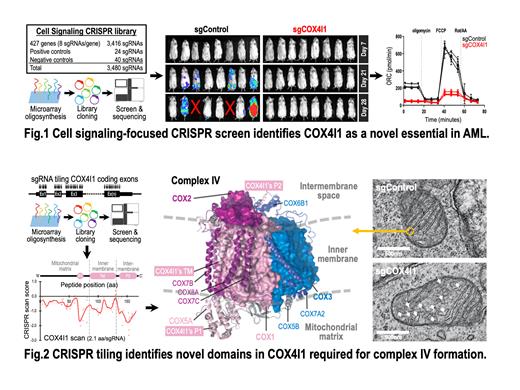Aberrant cellular signaling plays a pivotal role in the pathogenesis of acute myeloid leukemia (AML). Identifying key signaling components and their dependencies is crucial for advancing AML therapy. Here, we conducted a focused CRISPR library screen targeting 427 cell signaling-related genes with 3,416 sgRNAs (8 sgRNAs per gene) in the Cas9-expressing Molm13 AML cells. In addition to the known leukemia essential genes (MYC, RPS6, CCND3, GAB2, and AURKB), we discovered COX4I1 (Cytochrome c oxidase subunit 4 isoform 1) as a novel essential gene for AML maintenance (Fig. 1). CRISPR-knockout of COX4I1 in AML cells led to inhibited cell proliferation, reduced colony formation, and attenuated leukemia progression in vivo. Transcriptomic profiling revealed elevated mitochondrial stress upon COX4I1 knockout, accompanied by dysregulated mitochondrial cristae structure observed through transmission electron microscopy. Functional assays demonstrated impaired mitochondrial respiration (oxygen consumption rate, i.e., OCR, measured by Seahorse XF) and depleted cellular ATP (measured by metabolomic mass spectrometry) upon COX4I1 knockout in AML cells, highlighting the pivotal role of COX4I1 in mitochondrial homeostasis and energy metabolism.
COX4I1 is a nuclear-encoded mitochondrial protein located on the mitochondrial inner membrane. Using a high-density CRISPR gene tiling scan (Fig. 2; targeting density ~2.1 aa per sgRNA), we identified two critical COX4I1 peptide regions (P1: K67 - L73 and P2: E136 - K169) required for leukemia cell proliferation and mitochondrial respiration. Mechanistically, we found that expression of COX4I1 is essential for the assembly of mitochondrial complex IV, a crucial component of the electron transport chain involved in establishing the proton electrochemical potential across the mitochondrial inner membrane. Structural analysis revealed that facing the mitochondrial matrix, COX4I1's P1 region establishes the interface between COX4I1 and COX5A, which is necessary for the formation of the COX1 module. Conversely, COX4I1's P2 region (C-terminal 34 residues) is dispensable to the COX1 module formation; nonetheless, the P2 region co-localizes with the intermembrane space domains of the COX2/COX3 modules and is required for the assembling of an intact complex IV.
Finally, we found that knockout of COX4I1 induced mitochondrial stress further triggers cellular ferroptosis in AML cells, which is accompanied by an imbalanced cellular redox index (reduced GSH/GSSG ratio) and elevated lipid peroxidation (increased malondialdehyde). These notions led us to discover the critical role of COX4I1 as an opportunity for targeted AML therapy, especially when combined with mitochondria-targeting therapeutics such as Venetoclax (i.e., ABT-199).
In conclusion, our study highlights COX4I1 as a novel vulnerability in AML, controlling mitochondrial complex IV assembly and ATP biosynthesis. This finding holds promise for improving AML therapy and may be extended to identify therapeutically relevant signaling components in other hematopoietic malignancies.
Disclosures
No relevant conflicts of interest to declare.


This feature is available to Subscribers Only
Sign In or Create an Account Close Modal